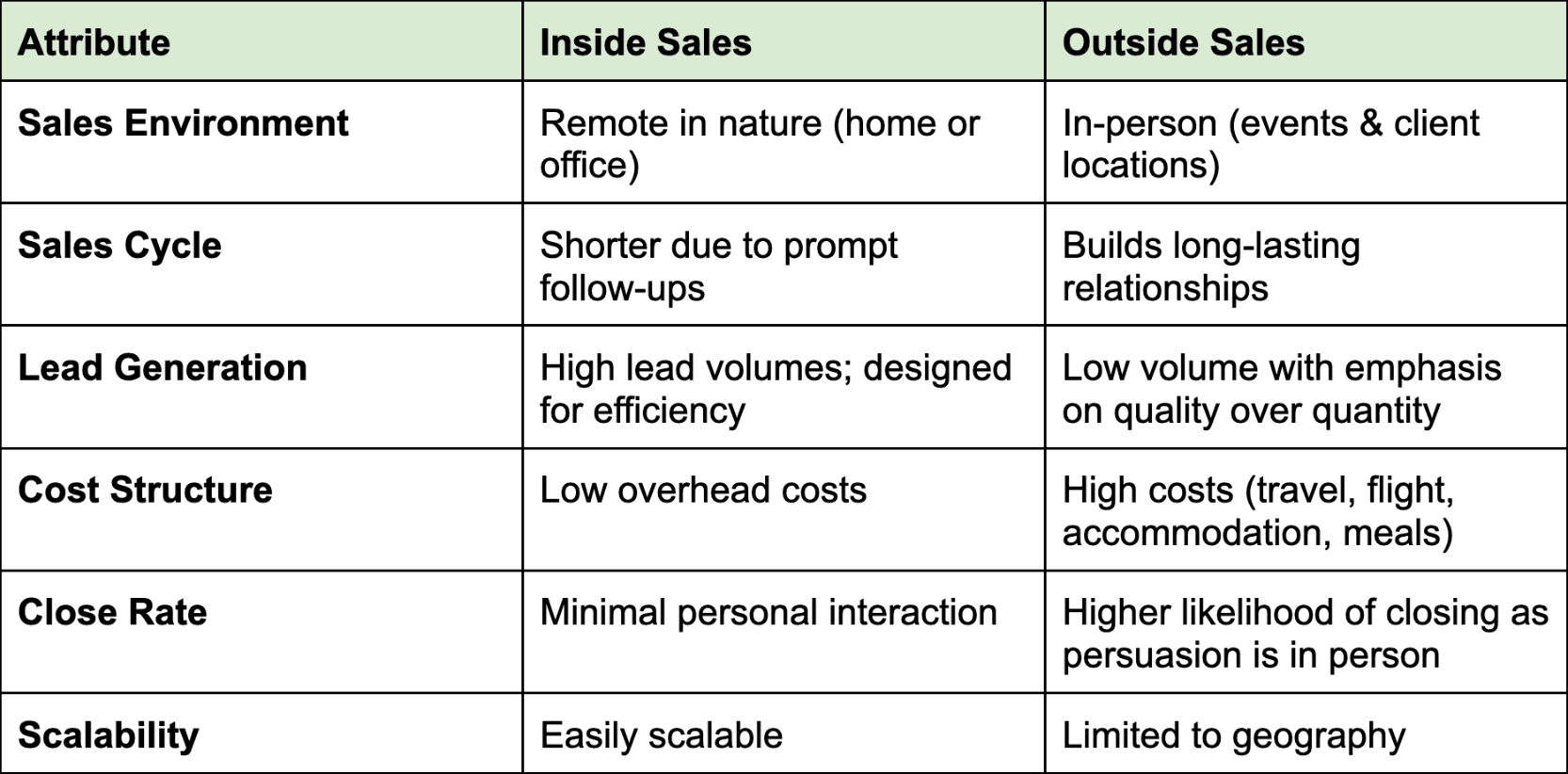Inside Sales vs. Outside Sales: Everything Covered
Is inside sales better than outside sales? Should your business adopt an inside sales or outside sales strategy? This decision was straightforward for many companies until the Covid-19 pandemic. Now, as everything gradually returns to normal, the question is: which model should businesses focus on?
Outdoor sales focus on customers with a high cost of acquisition or a high account value. Simplified, a high account value means when converted, they spend a lot of money on a company’s products and services to make frequent return purchases. On the other hand, indoor sales focus instead on high sales velocity. We shall later explore the benefits of each sales approach and how you get to pick the right one.
Read more: Discover 8 strategies for boosting your ecommerce sales
What is outside sales?
Outside sales means selling products and services in person through face-to-face interactions. This can happen at industry events, trade shows, the customer's office, a restaurant, or by going door to door. The sales territory depends on what reps are selling, industry norms, and each company's strategy. Outside sales are also called field sales, as most of their work time is outdoors.
What is inside sales?
Inside sales means selling products and services remotely instead of face-to-face. These professional salespeople use cold emails, phone calls, video conferencing, and others to maintain relationships with leads and other prospects.
At times, inside sales is referred to as virtual or remote sales, meaning it primarily takes place behind a desk. Inside sales teams are in a better position to sell to anyone, irrespective of geographical location. Companies in software as a service (SaaS) and e-commerce are among the most ardent users of this sales model.
Sales models: Key differences between inside sales vs. outside sales
Is inside sales better than outside sales? Market evolution has disrupted how B2B sales teams retail their products or services. In the past, the large players who retailed physical goods invested in outside sales teams, while the smaller players preferred an inside, cost-effective approach.
Companies are using technology to close deals that require physical demonstrations. Tools like Zoom, self-service, and live chat software have presented businesses with ways of making compelling product pitches with inside salespeople.
Here is how inside sales and outside sales compare. You can make a judgment call after looking at our overview comparison table below:

Now that we know what makes them different, let’s explore what inside sales reps do.
Read more: Learn how to build an AI ecommerce assistant
What does an inside sales representative do?

Photo by krakenimages on Unsplash
Inside sales representatives spend most of their time cold emailing, cold calling, and reaching out to different businesses while trying to generate new leads. A lot has changed when it comes to lead generation. Long ago, leads came from radio, print media, and cable TV ads. In the past decade, we've shifted to the digital era, where email, internet ads, landing pages, AI chatbots, and web forms generate leads. The internet has been the ultimate equalizer, accommodating businesses of all sizes, from small mom-and-pop to large multinational brands.
Inside sales reps do not personally meet their prospects, so they heavily use software tools when connecting with potential customers. They can convert a cold lead into a paying customer without leaving their work desk. In such a place, you need a stable internet connection to carry out phone calls.
Inside sales reps thrive with soft skills like understanding verbal and audible cues and having face-to-face meetings with clients. Inside sales have predictable schedules, so reps can figure out where a prospect is in the sales process and plan their day and week. For perspective, a rep might have a monthly sales quota of closing 10 sales. The average pipeline they might require to meet that number of paying customers is 200-250.
Understanding these benchmarks and what are the recurring qualities of a qualified lead helps you meet sales quotas. The secret is to isolate those high-value leads on your CRM software and optimize your time to make more sales.
Another upside to inside sales is its level of efficiency. For instance:
Reps administer the sales cycle from lead capture to conversion.
Shorter sales cycles are required for in-person meetings where reps must focus on sales
Reduced travel force inside reps to switch focus from one stage of sales funnel to the other
When leads go cold, reps easily pick up the next rather than waste time and resources organizing physical meetups.
Automation through social media messaging and outbound emails are an opportunity for sales managers to scale their operations. Back in the day, inside sales were telemarketing or call centers primarily driven through phone calls.
In the 2000s, it simply meant while seated in an office or fully remote. An inside sales approach helps representatives remotely sell products and services from their office or home environment. Let us look at some of the common examples:
Read more: Discover how to get more sales on Shopify
Examples of inside sales activities
Cold emails—reps will send out several emails to potential clients to gauge their interest in certain goods and services.
Video conferencing—reps will organize virtual meetings on platforms like Microsoft Teams, Zoom or Google Meets to perform product demonstrations, build rapport, and answer questions with prospective customers in real-time.
Social selling—work with customers on social media platforms like Linkedin while helping their sales teams in leading, contact sharing, and establishing candid relationships from in person interactions.
Lead qualification—Teams here rely on customer relationship management (CRM) systems when tracking leads and assessing the overall buyer readiness.
Webinars—hosting powerful educational webinars that allow sales reps to showcase their expertise when capturing information from leads.
Read more: Find out how Lookfor helped Nona Coffee cut support tickets by 80%
What does an outside sales representative do?

Photo by Tyler Franta on Unsplash
Outside representatives are assigned sales territories (which can be adjusted as needed) to meet clients at their business locations or offices. Salespeople involved here are account managers, business development reps, sales development reps, or customer success managers.
Deals can also be closed outside work settings in social places such as restaurants or golf courses, depending on the relationships. You can further meet businesses in markets that match ideal customer profiles (ICPs) or buyer personas. Outside sales reps have flexible work schedules and working hours that are different from your standard 9 to 5 depending on how they set up their meetings.
Like inside sales, the concept of selling is similar and also relies on sales enablement tools such as CRM or sales software. The sales channels for lead generation and follow-up are SMS, emails, and phone calls. Reps rely on sales tools to map out their sales territories and routes.
Here’s what a well-crafted outside sales strategy can do:
Directly building customer relationships
The rate of closing deals is relatively high compared to indoor sales as the customer meets the sales rep directly who can offer advice along the way
Generate new sales opportunities by interacting with people face-to-face
Sales reps are more motivated by higher compensation plans and commissions
Making in-person product pitches requires reps to use their interpersonal skills and body language. Being close to clients means you need to hire the right people.
Final thoughts
Technology and innovation keep blurring the line between inside and outside sales. Going into 2025 as companies plan to get ahead there is a huge potential for success. To meet your sales goals, you need to time things right and quickly adopt new trends that will be important in the next 5 years. Software tools have become a necessary part of the modern sales cycle and a sure way of remaining at par with the competition.
Supercharge your sales with Lookfor—AI-powered sales assistant designed that helps you close more deals on eCommerce.



